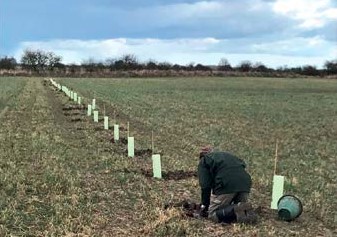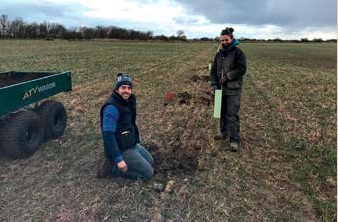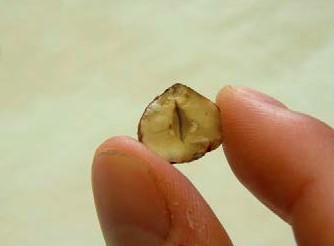
I’m finally and Agroforester!
It has been 5 years in the making, but we have finally planted our first 16 hectare field of Agroforestry.

We decided to do most of the work ourselves and I am so pleased we did. Farming has become quite an isolated world of technology, screens, twitter and stress along with some good times too of course! But if someone were to ask me what I enjoy the most from farming, it’s the time spent working with my close family doing manual work like planting our trees, not driving tractors. We spent the weekend chatting whilst planting, discussing the past, present and future, having laughs and enjoying the work. In the western world manual labour can be sometimes frowned upon, however it has such powerful effects on mental health and general wellbeing. My father (78), my son (2) and me (34) where all there to help with something that will shape our farms landscape for 50- 100 years. Bloody saw after digging 300 holes and shovelling compost and topsoil.
I have a weird affiliation with trees, have always been interested in them, they make me feel calm and somehow give me peace in what is a stressful lifestyle. I have no idea why, but my gut tells me that purely cropping annuals is not the right choice for my farm for the long term future. I maybe wrong and it’s not for everyone. Our agroforestry system was designed to overcome some key fears. We have planted it largely North/South to avoid the effects of shading.

Specs:
24m arable alleys, 4m tree strips, trees planted offset 1.5m from the east edge and 2.5m from the west edge. The offset is to allow harvest traffic on the west side (side where the sun sets which should be dryer). We have started jetting drains, however I am not too concerned about the drainage as trees generally don’t seek the drain unless its blocked. We also plan to install new drainage schemes down the arable alleys over the next 10 years. If I wasn’t on heavy land in the fens, I am convinced from research I have read, that trees may in themselves replace the need for field drains. They help, not hinder. Every tree has its purpose, and it has taken me about 50 books and 5 million hours on google to decide what to plant. We settled on two initial tree row types, the first field alternates these rows.
Row Type 1: Hazelnut – we chose a specific bunch of varieties which have never entered the UK before (a headache with Brexit), they are grown largely for Ferrero (who consume 1 in every 3 hazelnuts grown worldwide) they have a very specific bunch of characteristics which I liked. I was very cautious not just to plant “any tree” but to heavily research the commercial output of the crop, even if they are sold in our local town, they have to taste nice and be disease resistant etc. I was also careful to choose genetics that will suit our site in 10-15 years with climate predictions. Hazels have to blanch well and there is a “blanchability index” which is how well the skins come off during blanching. I don’t personally enjoy eating them with the skin on so spent some time looking at this.

Row type 2: Walnut (cash crop) with nurse trees of Italian Alder, Silver Birch and Wild Cherry.
The walnuts are the only “paying” crop in this row, we have chosen specific fruiting varieties that should suit our site and should grow on to provide an income for me, my son and future generations. The harvesting equipment for hazel and walnuts will be the same. Walnuts nutritionally are near to natures perfection, they are packed with protein (half the protein of chicken per gram), Omega 3, polyunsaturated fats as well as lowering the risk of heart disease, and whilst they grow they sequester carbon, produce oxygen, rebuild soil and provide super nutritional healthy food. Walnuts do contain Juglone (but less in the types I chose), which is alleopathic to crops such as sugar beet, maize and soya.

So why not just have tidy lines of walnuts? Because I am trying to completely shift the landscape to a diverse rich ecosystem. The Alder are great N fixing trees, they also grow just about anywhere, they are being planted in the field lows, and they are one of the best trees on the planet for restoring and regenerating soils. Silver Birch are equally hardy soil improvers, and they host over 300 species of insect, this is the main characteristic that swayed me, I want insects and I want to give them back a house on my farm and in my fields. The Cherry are mainly there for the flowers (aesthetics) and pollen for bees and other insects and fruit for birds. For every walnut there is 2 nurse trees 2m apart. Eventually we will fell the nurse trees and replant and use the timber.
Nuts have been described as natures perfect food. Before deciding to start with nuts I first started eating more of them, different types and varieties. They are nutritional powerhouses and they grow back every year… I have played in the kitchen and have some ideas as to what we will do with them before sale. We intend to crack and roast although some whole nuts for the Christmas market hopefully. There is no way, that we will be able to compete with a Turkish hazelnut or a Moldovan walnut, but that is not my aim. We want to put a face, brand and story behind a niche product. I also have to add that the nut shells are something we want to keep, combine with prunings/coppice and return to the land. We also plan to dry the nuts with the previous years shells using pyrolysis.
We plan to use the arable/pasture alleys to rotate livestock, crops, grass etc, we basically now have 13 fields in what was a square 16ha field. I have used the trencher to install some water pipe for livestock so each tree alley has a water supply should it be needed in the future. This was done very cheaply with blue water pipe and our drainage trencher. Our next field involves some berries and fruit as well (which I plan purely for the dried fruit product market not fresh (fresh would be a bonus). This will include some native and foreign berries and fruits.
Overall, I have to say, that I expect the tree rows to equal or surpass the gross margin for the arable crops on a per hectare basis and I hope they will improve and increase the arable yields. In time crops on the east side of the walnuts will suffer a little, but at that point the walnut income should surpass the arable. Its all about having diverse income streams. The carbon payments from the trees will add further income. Farmers are more than willing to visit our farm and field, I am passionate about agroforestry and am more than willing to share what I have learnt so far.